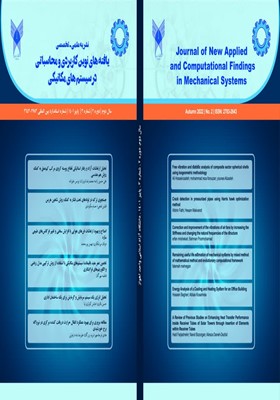تحلیل انرژی یک سیستم سرمایش و گرمایش برای یک ساختمان اداری
محورهای موضوعی : یافته های نوین کاربردی و محاسباتی در سیستم های مکانیکیحسین باقری 1 , عباس کوثری نیا 2 *
1 - گروه مکانیک،دانشکده مهندسی،دانشگاه آزاد اسلامی واحد اهواز،اهواز،ایران
2 - گروه مکانیک،دانشکده مهندسی،دانشگاه آزاد اسلامی واحد اهواز،اهواز،ایران
کلید واژه: "اقلیم", "ساختمان", "سیستم های تولید همزمان",
چکیده مقاله :
در این پژوهش به تحلیل و بررسی انرژی یک سیستم تولید همزمان سرمایش و گرمایش، برای یک ساختمان اداری با استفاده از انرژی خورشید در دو اقلیم متفاوت شامل شهرهای تبریز و زاهدان پرداخته شده است. به همین منظور ابتدا یک ساختمان نمونه اداری با ابعاد 7/112m2 در نرم افزار Hap 4.9 شبیه سازی شده و تغییرات انرژی مورد نیاز برای سرمایش و گرمایش در طول کل سال بیان می گردد. سپس جهت تأمین نیاز انرژی ساختمان مورد بررسی در شهرهای مذکور به بررسی عملکرد گرمایش و سرمایش یک سیستم آزمایشگاهی موجود در پژوهشگاه وزارت نیرو مستقر در شهر تهران، با تغییرات مورد نیاز برای ساختمان و اقلیم های مورد نظر پرداخته شده است. همچنین شایان ذکر است که برای شبیه سازی سیستم از نرم افزار شبیه سازی TRNSYS 16 استفاده شده و خروجی های سالانه سیستم برای هر دو اقلیم مذکور ارائه گشته است تا ارزیابی کارکرد سیستم سرمایش و گرمایش بیان گردد.
In this research, energy analysis of a cogeneration cooling and heating systems using solar energy for an office building for two various climates, namely Tabriz and Zahedan was presented. For this purpose, first, on office building measuring 112.7m2 was simulated in Hap4.9 software and required cooling and heating demand was calculated throughout a year. Afterwards, in order to meet the building energy requirement in the aforementioned regions, heating and cooling performance of an experimental apparatus, located in Niroo Research Institute in Tehran, was investigated with regarded alterations. TRNSYS 16 software was applied to simulate the system and the annual outputs for the climates were presented to evaluate the system.
[1] Elsheikh .M.H, Shnawah .D.A, Sabri .MF, Said .SB, Hassan .MH, Bashir MB, Mohamad M., (2014), A review on thermoelectric renewable energy: Principle parameters that affect their performance, Renewable and sustainable energy reviews,30, pp. 337-355. [2] Hwang Y, Radermacher R, Alili AA, Kubo I., (2008), "Review of solar cooling technologies," Hvac&R Research, 14(3), pp. 507-528. [3] del Amo Sancho A, (2014), "Solar trigeneration: A transitory simulation of HVAC systems using different typologies of hybrid panels," Journal of Sustainable Development of Energy, Water and Environment Systems, 2(1), pp. 1-14. [4] Li M, Mu H, Li N, Ma B., (2016), "Optimal design and operation strategy for integrated evaluation of CCHP (combined cooling heating and power) system," Energy, 99, pp. 202-220. [5] Calise F, Figaj RD, Massarotti N, Mauro A, Vanoli L., (2017), "Polygeneration system based on PEMFC, CPVT and electrolyzer: Dynamic simulation and energetic and economic analysis," Applied energy, 192, pp. 530-542. [6] Moaleman, A., A. Kasaeian, M. Aramesh, O. Mahian, L. Sahota, and G. Nath Tiwari, (2018), "Simulation of the performance of a solar concentrating photovoltaic-thermal collector, applied in a combined cooling heating and power generation system," Energy conversion and Management, 160, pp. 191-208. [7] Uçkan, I., A. A. Yousif ,(2019), "Simulation of a solar absorption cooling system in Dohuk city of the Northern Iraq," Energy Sources, Part A: Recovery, Utilization, and Environmental Effects, 42(14), pp. 1716-1732. [8] Bagheri H, Azimi, A., (2020), "Thermodynamic analysis of a CCHP system for a building using solar collectors and PV panels in two different climate zones in Iran," Energy Sources, Part A: Recovery, Utilization, and Environmental Effects, pp. 1-20.
[ 9[ سازمان مدیریت و برنامهریزی، ) 1382 (، نشریه شماره 271 شرایط طراحی برای محاسبات تأسیسات گرمایی، تعویض
هوا و تهویه مطبوع ویژه تعدادی از شهرهای کشور، چاپ اول، انتشارات سازمان مدیریت و برنامهریزی کشور .
[ 10 [ وزارت مسکن و شهرسازی، مبحث 19 مقررات ملی ساختمان، ) 1389 (، چاپ اول، انتشارات مرکز تحقیقات ساختمان
و مسکن.

